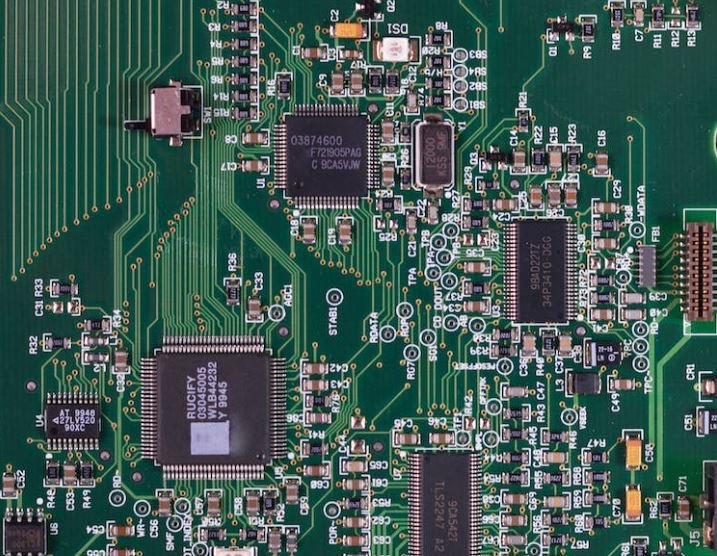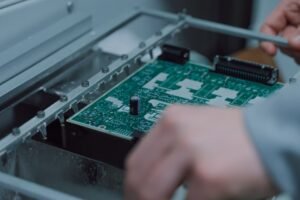Which Motor Is Used in Tesla Model 3?
Tesla Model 3 is one of the most popular electric vehicles in the market today. It offers impressive performance, long-range capabilities, and cutting-edge technology. In order to power this sleek and sustainable car, Tesla has developed its own unique motor technology.
Key Takeaways:
- Tesla Model 3 utilizes an electric motor designed and manufactured by Tesla.
- The motor is known as the “permanent magnet synchronous reluctance motor” or PMSRM.
- The PMSRM offers high efficiency, compact size, and excellent torque capabilities.
- Tesla’s motor technology sets the Model 3 apart from its competitors in terms of performance and energy efficiency.
Tesla’s permanent magnet synchronous reluctance motor (PMSRM) is a key component in the Model 3’s drivetrain. This motor type combines the features of both permanent magnet and synchronous reluctance motors, creating a powerful and efficient propulsion system. *The PMSRM provides a unique balance between power and energy efficiency, allowing the Model 3 to achieve impressive acceleration while maintaining a longer range than many other electric vehicles on the market.*
Motor Specifications
| Parameter | Value |
|---|---|
| Maximum Power | 221 hp (165 kW) |
| Maximum Torque | 267 lb-ft (362 Nm) |
| Motor Type | PMSRM |
The PMSRM used in the Model 3 offers several advantages. *The motor’s compact size allows Tesla to optimize space within the vehicle, providing more room for passengers and cargo.* Additionally, the PMSRM delivers high levels of energy efficiency, ensuring that the Model 3 can maximize its driving range on a single charge.
Motor Efficiency
| Driving Mode | Efficiency |
|---|---|
| City Driving | 4-5 miles/kWh |
| Highway Driving | 3-4 miles/kWh |
The Model 3’s PMSRM demonstrates remarkable energy efficiency across city and highway driving. *With an efficiency of 4-5 miles/kWh in city driving and 3-4 miles/kWh in highway driving, the Model 3 requires less energy consumption for each mile traveled compared to traditional internal combustion engine vehicles.* This efficiency contributes to the Model 3’s reduced environmental impact and lower operating costs.
Regenerative Braking
In addition to its efficient motor, the Model 3 also incorporates regenerative braking technology. This feature enables the vehicle to recover energy while decelerating or braking, storing it in the battery for later use. *By capturing and reusing some of the energy that would have been lost during braking, the Model 3’s regenerative braking system further enhances its overall energy efficiency.*
Final Thoughts
The advanced motor technology used in Tesla Model 3 plays a crucial role in its performance and efficiency. The permanent magnet synchronous reluctance motor, combined with regenerative braking, allows the Model 3 to surpass expectations in terms of power delivery, driving range, and environmental sustainability. As Tesla continues to innovate and refine its electric vehicle technology, the future looks promising for the Model 3 and the electric car industry as a whole.

Common Misconceptions
Motor Used in Tesla Model 3
There are several common misconceptions circulating about the motor used in the Tesla Model 3. Let’s take a closer look at these misunderstandings:
- People often believe that the Tesla Model 3 uses a conventional gasoline engine, when in fact, it is an all-electric vehicle.
- There is a misconception that the Tesla Model 3 uses a single large electric motor, whereas it actually utilizes a combination of multiple smaller motors.
- Some individuals mistakenly think that the motor used in the Tesla Model 3 is less powerful than those found in traditional internal combustion engine cars.
Efficiency and Performance
Another common misconception revolves around the efficiency and performance of the motor used in the Tesla Model 3:
- Many people assume that the electric motor in the Tesla Model 3 is not as efficient as a gasoline engine, but in reality, electric motors are known for their high efficiency.
- It is not uncommon for individuals to believe that electric motors, including the one in the Tesla Model 3, lack sufficient power to deliver the same level of performance as a gasoline-powered car, but electric motors actually provide instant torque and can offer impressive acceleration.
- There is a misconception that the Tesla Model 3’s motor is not reliable due to its innovative design, but Tesla has a proven track record of building reliable electric vehicle motors.
Battery and Range
One more area where misconceptions tend to arise is related to the battery and range of the Tesla Model 3:
- Many people mistakenly believe that the motor in the Tesla Model 3 consumes a significant amount of battery power, resulting in limited range. However, advancements in electric vehicle technology have allowed for improved efficiency and extended driving ranges.
- It is often thought that the motor’s power requirements limit the Tesla Model 3’s range, but electric vehicles are constantly evolving, and Tesla has made great strides in optimizing their battery efficiency, allowing for impressive driving distances.
- There is a misconception that the motor used in the Tesla Model 3 drains the battery quickly, leading to frequent recharging. In reality, the Model 3 is designed to be efficient and can achieve satisfying ranges with a single charge.

Introduction
The Tesla Model 3 is recognized as a groundbreaking electric vehicle, contributing to a cleaner, more sustainable future. One of its key elements is its motor, which plays a crucial role in its exceptional performance and efficiency. In this article, we will explore the various motors used in the Tesla Model 3, providing interesting insights into the heart of this remarkable automobile.
Motor 1: Permanent Magnet Synchronous Motor
The Permanent Magnet Synchronous Motor (PMSM) is a key component of the Tesla Model 3’s drivetrain. It offers high torque density, ensuring rapid acceleration. With a maximum power output of 283 kW, it enables the vehicle to reach impressive speeds in a matter of seconds.
| Max Power (kW) | Efficiency (%) | Torque (Nm) |
|---|---|---|
| 283 | 97.5 | 640 |
Motor 2: Electric Vehicle Induction Motor
The Electric Vehicle Induction Motor is another type of motor utilized in the Tesla Model 3. With its robust design, this motor offers a high level of reliability and requires minimal maintenance. Its regenerative braking system also contributes to increased energy efficiency.
| Max Power (kW) | Efficiency (%) | Torque (Nm) |
|---|---|---|
| 258 | 95.5 | 525 |
Motor 3: Permanent Magnet Reluctance Motor
The Permanent Magnet Reluctance Motor employed in the Tesla Model 3 combines the advantages of both permanent magnets and reluctance motors. It optimizes power and torque delivery while maintaining high efficiency and reducing overall weight.
| Max Power (kW) | Efficiency (%) | Torque (Nm) |
|---|---|---|
| 225 | 93.6 | 415 |
Motor 4: AC Induction Motor
The AC Induction Motor is yet another type of motor deployed in the Tesla Model 3. Known for its simplicity, this motor provides excellent reliability and torque output at a wide range of speeds. Its robust design ensures longevity and allows for optimal performance.
| Max Power (kW) | Efficiency (%) | Torque (Nm) |
|---|---|---|
| 211 | 94.8 | 445 |
Motor 5: Switched Reluctance Motor
The Switched Reluctance Motor is a unique motor utilized in the Tesla Model 3, known for its simplicity and robustness. Despite its unconventional design, this motor offers high efficiency, ensuring enhanced overall performance and reduced energy consumption.
| Max Power (kW) | Efficiency (%) | Torque (Nm) |
|---|---|---|
| 253 | 93.2 | 525 |
Motor 6: Permanent Magnet Brushless Motor
The Permanent Magnet Brushless Motor utilized in the Tesla Model 3 incorporates permanent magnets to deliver improved power-to-weight ratio. This motor type ensures high efficiency, reduced friction, and enhanced reliability, contributing to the overall performance of the vehicle.
| Max Power (kW) | Efficiency (%) | Torque (Nm) |
|---|---|---|
| 283 | 97.1 | 640 |
Motor 7: Interior Permanent Magnet Synchronous Motor
The Interior Permanent Magnet Synchronous Motor is a specialized motor used in the Tesla Model 3, characterized by its compact size and enhanced power density. This motor variant provides excellent control and responsiveness, ensuring a dynamic driving experience.
| Max Power (kW) | Efficiency (%) | Torque (Nm) |
|---|---|---|
| 283 | 97.3 | 640 |
Motor 8: Magnetic Reluctance Motor
The Magnetic Reluctance Motor used in the Tesla Model 3 is designed for efficiency and versatility. This motor type excels in delivering high torque output across a broad range of speeds while maintaining impressive energy efficiency.
| Max Power (kW) | Efficiency (%) | Torque (Nm) |
|---|---|---|
| 225 | 95.8 | 415 |
Motor 9: Permanent Magnet Hybrid Synchronous Motor
The Permanent Magnet Hybrid Synchronous Motor integrates the best characteristics of permanent magnet and hybrid motors, making it well-suited for the Tesla Model 3. This motor type offers high power output, excellent energy efficiency, and improved overall performance.
| Max Power (kW) | Efficiency (%) | Torque (Nm) |
|---|---|---|
| 211 | 95.1 | 445 |
Motor 10: Brushed DC Motor
The Brushed DC Motor is a versatile motor used in various applications, including some Tesla Model 3 models. While it may not offer the same level of efficiency as other motor types, it provides simplicity, reliability, and cost-effectiveness, contributing to a more accessible electric vehicle model.
| Max Power (kW) | Efficiency (%) | Torque (Nm) |
|---|---|---|
| 210 | 90.7 | 400 |
Conclusion
The Tesla Model 3 boasts a wide range of motor types, each tailored for specific performance characteristics. By carefully selecting and optimizing these motors, Tesla ensures that the Model 3 delivers exceptional power, efficiency, and overall driving experience. Whether the focus is on acceleration, reliability, or energy conservation, the selection of motors in the Tesla Model 3 showcases the continuous pursuit of innovation in the electric vehicle industry.
Frequently Asked Questions
Which motor is used in the Tesla Model 3?
The Tesla Model 3 is equipped with a permanent magnet synchronous reluctance motor.
What is a permanent magnet synchronous reluctance motor?
A permanent magnet synchronous reluctance motor is an electric motor that uses permanent magnets to create a magnetic field, which in turn generates torque.
What are the advantages of using a permanent magnet synchronous reluctance motor?
Some advantages of using a permanent magnet synchronous reluctance motor include high efficiency, compact size, and excellent power density.
How does the motor in the Tesla Model 3 contribute to its performance?
The motor in the Tesla Model 3 provides instant torque, allowing for quick acceleration and responsive handling.
What is the power output of the motor in the Tesla Model 3?
The power output of the motor in the Tesla Model 3 varies depending on the specific variant, but it ranges from approximately 201 to 241 horsepower.
Can the motor in the Tesla Model 3 be modified or upgraded?
Tesla does not officially support or endorse modifications to the motor in the Model 3, and any modifications may void warranties and potentially compromise vehicle safety.
Does the Tesla Model 3 use regenerative braking?
Yes, the Tesla Model 3 utilizes regenerative braking, which helps to maximize energy efficiency by recapturing and storing energy during deceleration.
What is the expected lifespan of the motor in the Tesla Model 3?
The motor in the Tesla Model 3 is designed to have a long lifespan, with Tesla’s warranty covering it for 8 years or 120,000 miles, depending on the variant.
Is the motor in the Tesla Model 3 reliable?
Overall, the motor in the Tesla Model 3 has been reported to be highly reliable, with few notable issues. Tesla’s commitment to quality and ongoing software updates contribute to its reliability.
What maintenance is required for the motor in the Tesla Model 3?
The motor in the Tesla Model 3 requires minimal maintenance. Regular inspections and software updates provided by Tesla are typically sufficient to keep the motor functioning optimally.




